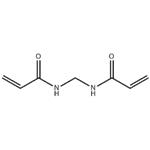A Deep Dive into N, N′-Methylenebisacrylamide: Synthesis, Composition, Applications, and Storage
May 21,2024
Introduction
N, N′-Methylenebisacrylamide (MBAm), a critical chemical crosslinker, is indispensable in the synthesis of polyacrylamide gels, which are essential for a variety of biochemical applications. Recognized for its robustness and versatility across diverse chemical fields, MBAm has garnered significant attention and esteem within the scientific community. This compound's ability to effectively form stable, intricate network structures makes it a preferred choice in laboratories and industrial processes alike. This article aims to deliver a comprehensive overview of MBAm, covering aspects from its chemical synthesis and primary components to its broad applications and essential storage practices. Through this exploration, we provide chemistry professionals with a deep understanding of MBAm's role and utility in advancing scientific and industrial endeavors.

Figure 1 Characteristics of N, N′-Methylenebisacrylamide
Synthesis of N, N′-Methylenebisacrylamide
The synthesis of N, N′-Methylenebisacrylamide begins with the reaction between methylenebisamide and acryloyl chloride. This process involves a complex reaction mechanism where the amide groups of methylenebisamide are converted into acrylamide groups through a nucleophilic substitution reaction. Typically, the synthesis is carried out under controlled conditions to ensure high purity and yield of the final product. Advances in synthesis techniques have focused on improving the efficiency and environmental sustainability of this process, with catalytic methods and solvent-free reactions gaining prominence.
Main Components
MBAm's structure features two acrylamide groups linked by a methylene bridge, which is pivotal for its crosslinking capabilities. This bisacrylamide compound is primarily composed of carbon, nitrogen, oxygen, and hydrogen atoms, arranged to form a robust, reactive molecule. The unique molecular arrangement allows MBAm to form crosslinks between polyacrylamide chains, facilitating the creation of a three-dimensional polymer network that is crucial for its application in gel-based technologies.
Applications of N, N′-Methylenebisacrylamide
The applications of N, N′-Methylenebisacrylamide (MBAm) are expansive and integral to numerous scientific and industrial fields. Primarily, its role in the synthesis of polyacrylamide gels is critical for gel electrophoresis, which is pivotal in biochemical research for the separation and analysis of proteins and nucleic acids. This process allows scientists to identify molecular components with high precision, facilitating advancements in genetic research and molecular biology.
Beyond the laboratory, MBAm is instrumental in the production of water-soluble polymers that are essential in agricultural applications, serving as soil conditioners to improve soil structure and hydration properties. In the environmental sector, it acts as a flocculating agent in wastewater treatment plants, enhancing the sedimentation and removal of particulates, thus significantly improving water clarity and quality.
In medical technology, MBAm's capabilities extend to the creation of hydrogels that are used in drug delivery systems and tissue engineering. These hydrogels can mimic the natural tissue environment, making them ideal for sustained drug release and supporting cell growth in tissue scaffolds. This adaptability makes MBAm a vital component in developing advanced therapeutic solutions, including wound healing applications and regenerative medicine, further underscoring its versatility and critical role in modern science and technology.
Storage Practices for N, N′-Methylenebisacrylamide
Proper storage of N, N′-Methylenebisacrylamide (MBAm) is critical to preserve its chemical integrity and ensure its effectiveness in applications. It is imperative to store MBAm in environments maintaining temperatures below 25°C (77°F) to prevent any premature polymerization or breakdown of the compound. Containers should be air-tight and made of non-reactive materials like glass or specific types of plastics, such as polyethylene, which ensure no chemical interaction. Long-term exposure to air can lead to oxidation reactions, which may degrade MBAm, while moisture can trigger unwanted polymerization, rendering the substance ineffective for precise scientific work. Furthermore, MBAm should be stored away from oxidizing agents and bases, which can dramatically accelerate its degradation. Handling MBAm requires careful attention to safety, including the use of gloves, goggles, and lab coats, to protect against skin and eye irritation and potential respiratory issues. By adhering to these guidelines, laboratories, and industries can maintain MBAm's quality over time, ensuring reliable results in various applications.
Conclusion
N, N′-Methylenebisacrylamide is an essential chemical in the domain of polymer chemistry, renowned for its ability to form stable, intricate polymer networks. Its synthesis, while complex, yields a versatile product used in various scientific and industrial applications. Understanding the chemical’s composition, applications, and proper storage methods is imperative for professionals in the chemical industry. As research progresses, the potential for new and innovative applications of MBAm continues to expand, promising exciting developments in the field of chemistry and material sciences.
References
[1]Donia, Ahmed M., et al. "Adsorption of Ag (I) on glycidyl methacrylate/N, N′-methylene bis-acrylamide chelating resins with embedded iron oxide."Separation and Purification Technology48.3 (2006): 281-287.
[2]Carretero, L., et al. "Acrylamide-N, N’-methylenebisacrylamide silica glass holographic recording material."Optics Express12.8 (2004): 1780-1787.
- Related articles
- Related Qustion
Supplementation with pyridoxal 5'-phosphate monohydrate can synthesize neurotransmitters such as dopamine and serotonin, maintaining a healthy nervous system.....
Nov 4,2025Biochemical EngineeringFerrous sulfate monohydrate, a derivative of iron sulfate, is a chemical compound that plays a crucial role in various industrial and environmental processes.....
May 21,2024APIN,N'-Methylenebisacrylamide
110-26-9You may like
N,N'-Methylenebisacrylamide manufacturers
- N,N'-Methylenebisacrylamide
-

- $0.00 / 1KG
- 2025-12-19
- CAS:110-26-9
- Min. Order: 1KG
- Purity: 98%min
- Supply Ability: 10tons/month
- N,N'-Methylenebisacrylamide
-

- 2025-12-19
- CAS:110-26-9
- Min. Order:
- Purity: 0.99
- Supply Ability:
- N,N'-Methylenebisacrylamide
-

- $0.00 / 25Kg/Drum
- 2025-12-18
- CAS:110-26-9
- Min. Order: 1KG
- Purity: 99%
- Supply Ability: 1000mt






